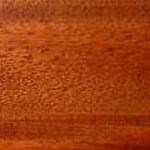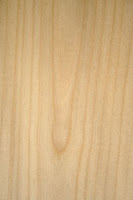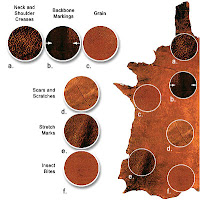- Buy on comfort and price, and make sure you can return the mattress if you find it’s not as comfortable as you expected.
- The only way to choose a new mattress is to lie on as many as possible. We give you tips on what to look for and how best to test when you hit the shops.
- Replace your mattress every 10 years. Using the same one for too long can cause back and neck problems, not to mention hygiene risks.
 Mattress Sizes
Mattress Sizes- Twin 39" x 75" (also known as single) Most common for childrens' rooms, Daybeds, Trundle units and hideaways.
Twin Extra Long 39" x 80"
Is generally used in college dorm rooms and is 5" longer than a standard twin. Bedding may be harder to find and available only a limited variety of pattes. Approx. width per person: 39"
Pros: Standard fare in college dorms. Longer length is good for taller teens and adults. Still easy to make.
Cons: Bedding can be harder to find. - Double 54" x 75" (also known as Full)
Double beds are only 15" wider than a Twin bed. This won't leave much elbow room for 2 adults (each will have only 27" of width vs. 39" in a Twin bed). Too, a Double bed is only 75" long which may be too short for some adults. Approx. width per person: 27"
much elbow room for 2 adults (each will have only 27" of width vs. 39" in a Twin bed). Too, a Double bed is only 75" long which may be too short for some adults. Approx. width per person: 27"
Pros: Fits into smaller rooms. Sheets are less expensive than queen or king size.
Cons: Many people find a Double is too narrow for 2 adults with only 27" in width for each person. And, it may be too short for some. - Queen 60" x 80"
Queen Beds are 6" wider (and 5" longer) than a Double bed. These added inches can make all the difference in comfort, but each adult still has 9" less than the width of a standard Twin bed. However, it's a good choice for guest rooms and smaller master bedrooms. Approx. width per person: 30"
Pros: A better fit for 2 adults. The 80" length comfortably accommodates most adults. Bedding is easy to find.
Cons: At only 30" of wide for each person (only 3" wider than a Double) many people find a Queen is still too narrow for comfortable sleeping for a couple. Note that some bedding is sold as "Full/Queen" and may not perfectly fit either size, so check the measurements before purchasing. Can use standard pillows or the slightly larger queen size pillows. - King 76" x 80" Also known as Eastern King
King is about 16" wider than a Queen bed. Both are about 80" long. The Eastern King is the only bed to give each person the same width as a Twin bed. In fact you can push 2 Extra-Long Twin beds together to be the same size as an Eastern King. This is a good way to have a versatile guest room (use 2 twins separately or push together to make a king bed for couples). An Eastern King bed comes with one mattress and two half-width box springs to be more manageable when moving. Approx. width per person: 38"
Pros: This is the widest standard bed available. Roomy enough for 2 large adults. The 80" length comfortably accommodates most people. Sheets are easy to find and are generally labeled simply "King".
Cons: This is a very large mattress that may not fit easily up stairs or into smaller rooms. (Check bendability on king size mattresses)Taller people may prefer the California King instead with its longer length. All bedding is most expensive in king sizes. Needs 3 standard pillows or 2 king pillows for this width. - California King 72" x 84"
California King is 12" wider than a Queen bed but adds 4" in length. This may be a better choice for taller adults. This size is sometimes known as the "Western King". Bedding may be labeled either "California King" or "Western King". A California King bed set comes with one mattress and two half-width box springs to be more manageable when moving. Approx. width per person: 36"
Pros: A California King size mattress is roomy in width for 2 adults. Also, it is the longest standard bed available at about 84", and is ample for most taller people.
Cons: This is a very large mattress that may not fit easily up stairs or into smaller rooms. Sheets are plentiful on the West Coast but may be a bit more difficult to find in other parts of the country, so try looking for them online if you're not on the West Coast. Needs 3 standard pillows or 2 king pillows for this width. All bedding is most expensive in king sizes.
There’s no scientific consensus on what makes a good mattress. People around the world sleep comfortably on all sorts of beds: straw mats, hammocks, futons, waterbeds, airbeds and all manner of mattress. In a market where what feels good is good and comfort is subjective, it comes down to you — what feels comfortable, what you can afford, and what you can do if your new mattress turns out not to suit you.

Time for a change?
Manufacturers and chiropractors recommend you replace your mattress around every 10 to 13 years, depending on how it’s treated. If it’s on a sprung base, plan to replace it every 12 or 13 years. A mattress on an unsprung base (including fixed-slat bases) should last about 10 years. See Good foundations for more on bases.
If your mattress is of poor quality or you don’t look after it properly (see Caring for your mattress), it may not last this long. And in any case, it’s recommended you replace your mattress at least every 10 years for hygiene reasons.
Some obvious signs you need a new mattress are annoying peaks, dips or lumps, or if you wake up stiff. If it’s uncomfortable, interferes with your sleep or leaves you with a backache, it’s definitely time to act.
Another reason for regularly renewing your mattress is that your needs change as your body ages. As you get older, your body will appreciate softer padding to support and protect pressure points. But don’t confuse softer padding with a soft, saggy bed — the underlying structure should be firm enough to support your spine as it gradually loses strength and flexibility. Furthermore, you may have difficulty moving around in — and getting out of — a bed that’s too soft.
Your options
There’s a variety of mattresses and bed bases on offer these days, and what’s best for you ultimately comes down to personal preference. Most people buy an inner-spring mattress and box base or slatted bedstead, so we’ll concentrate on this set-up. Latex and foam mattresses, futons and waterbeds are discussed in Alternatives. We also take a look at the new kid on the block: viscoelastic mattresses — see Memory foam.
You can’t tell much about the quality of a mattress by looking at it from the outside — you’ll have to rely on knowledgeable and helpful salespeople and cutaway models in stores. (If you don’t find either of these, go elsewhere.) However, it helps to know something about the structure of a mattress before you go shopping so you know what to look for, what to ask, and how to understand the answers.
Springs
The spring unit is the main source of support for your body. Five factors can influence the degree of comfort, support and durability of a mattress: the number of springs or coils, their shape, the gauge of wire used, th
 e number of turns in each spring and the distribution of the springs.
e number of turns in each spring and the distribution of the springs.The final effect will depend on an interplay of all these factors. So, for instance, more springs aren’t necessarily better if they’re lower in quality. Let comfort, rather than stats, be the deciding factor.
The number of springs: There should be at least 300 coils in a double bed, 375 in a queen-size and 450 in a king-size. But otherwise, more doesn't necessarily mean better - let comfort be your guide.
Spring shape: There are several shapes of spring, and it may be a good idea to try lying on the different kinds, as one type may suit you better.
Hourglass-shaped springs are used in the original inner-spring system, called the Bonnell System. They’re joined together with spiral wires to form the unit. They compress quite easily at first, but then get firmer the mor
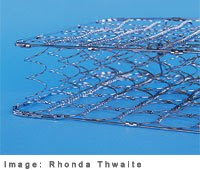 e they’re compressed (hence offering more support), resulting in a ‘soft but firm’ bed. They tend to be found in cheaper mattresses.
e they’re compressed (hence offering more support), resulting in a ‘soft but firm’ bed. They tend to be found in cheaper mattresses.Continuous coil springing is made from a single length of wire shaped into a system of coils. It means manufacturers can increase the density of coils, which they claim gives greater support and minimises partner disturbance. The number of springs or coils is irrelevant in a continuous system.
Open-ended coils are joined together part-way down the sp
 ring, rather than at the top so that the ‘open end’ is left free.
ring, rather than at the top so that the ‘open end’ is left free.Image right: The blue part of this premium open-ended coil is joined to neighbouring springs, leaving the entire gold-coloured part of the spring is free.
Open-ended coils are joined together to form a spring system, but the top (and bottom, for a double-sided mattress) of each coil is free to move independently. This allows each coil to adjust to the weight on it, with the free-moving bit compressing relatively easily for comfort, and the body of the coil offering more resistance and therefore firmer support. Because there’s more turns -- and therefore wire -- in these springs, they tend to be more expensive than Bonnell or continuous coil systems.
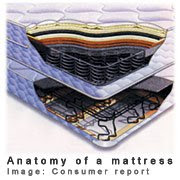
Pocket-spring mattresses consist of a grid of springs, each in their own fabric pocket. Because they’re not wired together, each spring is able to work more or less independently — the weight on one spring doesn’t affect those surrounding it (except for pull by the mattress cover). Tests by our German counterparts consistently rate pocket-spring mattresses the most comfortable type of inner-spring mattress.
Hourglass-shaped Bonnell springs and continuous coils are joined at the top and bottom to form a single spring unit, while pocket springs are able to move more or less independently (though the mattress coverings limit complete independence). Open-ended coils are joined together part-way down the spring, rather than at the top (which is free). The most comfortable spring system comes down to personal preference and depends, among other things, on your size and weight, and whether you sleep alone or with a partner.
Wire gauge: Not all springing systems are made from wire with the same strength, durability and quality. Ask for information about the gauge of wire used in a mattress. The lower the number, the more durable the wire (that is, 13-gauge wire is thicker and stronger than 16-gauge). Wire may also be measured in millimetres — obviously the higher the number the thicker it is.
Active turns: A further variation is the number of active turns in the spring or coil — that is, the number of turns that are absorbing and supporting the weight of the body. The more turns, the softer the bed and the longer the springs will last because the work is spread around.
Distribution of springs: Some beds differentiate support zones in the mattress, usually putting firmer springs in the centre third of the bed to support your heavy bits. It’s difficult to confirm whether they really add to the quality of support offered by the mattress.
Some also include side or edge support springs, which provide more strength and support at the edge of the mattress, and protect against the spring and comfort systems breaking down around the edge of the bed (which is thought to be a major cause of mattress failure).
Padding and ticking
The comfort layer is what lies between you and the springs — it determines how hard or soft the mattress feels against your body.
A manufacturer that makes a large range of mattresses will often use the same spring unit but vary the fillings — the more expensive the mattress
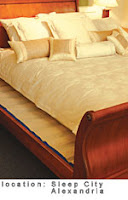 , the better the filling. And the better the filling, the longer the mattress should last.
, the better the filling. And the better the filling, the longer the mattress should last.At the top end of the market (over $2500) fillings include silk, wool, cashmere, premium foams, latex and goosedown. At the lower end (under $700), materials include lower grades of foam, reclaimed cotton fibres and coconut fibre. These don’t tend to last as long because they break apart more easily, forming lumps and pockets, and lose their ability to spring back more quickly. A $7000 bed won’t last seven times as long as a $1000 one, however — you’re paying the price for luxury rather than durability.
You might want to think twice about getting a ‘pillow top’ mattress (where a separate thick layer of padding is attached to the top and bottom of the mattress). They tend to lose their ability to bounce back over time. We've had complaints from consumers to this effect, and the mattresses are very expensive. If you want extra cushioning, buy a separate padded overlay made from foam, feathers, cotton, latex or memory foam, and replace it when needed.
The way in which the padding is secured in place can also influence how well the bed maintains its comfort. In top-of-the-range mattresses, each layer is handstitched into place to prevent the materials shifting around. This is a specialist craft (called hand-tufting) and can take one person several days. Retailers should know which mattresses are hand-tufted — they’ll be the expensive ones.
As far as the outer cover (or ticking) goes, cheaper, less durable mattresses will probably have a flat cotton cover, while more expensive ones have quilted damask covers (linen, silk, cotton or wool fabric woven with patterns) - which will get covered up with a sheet!
Good foundations
Box bases
A typical ‘ensemble’ consists of a box base and inner-spring mattress. Some box bases are simply that: a wooden box with a board or slats across the top, covered with fabric to match the mattress. Others have internal springs, which take some of the load from the mattress, helping to extend its life. When you’re thinking about a new mattress, take a good look at the condition of your base — if it’s sagging or worn you may need to replace it too, as it won’t support your new mattress properly and will shorten its life. Some companies won't honour warranties if you've used the mattress on a base they consider inadequate.
Slatted bases
There are two types: fixed and flexible slats. Flexible slats are attached to the frame with pivoting holders and allow some give. Fixed slats — the more common of the two — attach straight to the frame and offer little or no give to the mattress. Latex and foam mattresses work best on a flexible slat base; fixed slats are fine for inner-spring mattresses.
Despite what you may see or read, one major manufacturer tells us there’s no such thing as a mattress that shouldn’t go on a slatted base. A mattress may last longer on a sprung base, but a slatted-base bedstead itself could last a lifetime (unlike a sprung base).
Make sure the slats aren’t too far apart — about 5 cm or 2" is good.
People who are elderly or infirm and those who have asthma or back problems have special needs, and should consider the following points when choosing a mattress:
- An inner-spring mattress can be very heavy and may be difficult to flip or turn regularly by people who are older or have back problems. A foam mattress may be a better option, or look for a one-sided (no-flip) mattress (though these should still be rotated).
The same people may have difficulty getting into and out of a bed that’s too high or too low. When you sit on the edge of the bed, your feet should reach the ground comfortably, and you shouldn’t need to use much effort to stand.
- If you’re prone to pressure pain from sitting or lying in the same position for too long, choose a mattress with soft padding. Don’t go too soft — the underlying support (provided by the spring unit) should be firm enough to allow you to roll over and sit up easily. The softness should come only from the surface cushioning.
Beds with names involving ‘paedic’, ‘chiro’, ‘ortho’ and so on aren’t necessarily better for you than others without medical-sounding terms — it could just be the marketing.
- Also be wary of endorsements from medical-sounding organisations. While some are legitimate, in some cases manufacturers buy the rights to use one, rather than earn it, and other manufacturers have been found to claim endorsements from impressive-sounding but non-existent organisations.
- Although a firm bed can help some lower back pain, a bed that’s too firm could also aggravate some back conditions. Some back problems may benefit from a soft bed, so it’s important to ask your doctor or back-care specialist for advice first.
- Asthmatics and allergy sufferers may find that an anti-allergy cover will help prevent dustmites settling in the mattress. Vacuum your mattress regularly. A slatted bed base will improve ventilation and provide fewer places for allergens to accumulate.
Some people prefer the look or feel of other types of mattresses to the inner-spring type we’ve looked at here.
Alternatives include:
Futons
Originally from Japan, futons are basically big cushions filled with fluffed-up cotton, wool and/or artificial fibres. You need to keep the fillings well-ventilated and fluffed-up, and they must be turned regularly to avoid mildew — and they’re often just as heavy as an inner-spring mattress. They’re harder than most other types of mattress and may better suit people with a small, light build, as they won’t adapt to your curves and bumps as readily.
Waterbeds
They’re claimed to give good body support without pressure
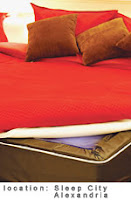 points, and may be good for allergy sufferers. Good support depends on the amount of water in it, so make sure it’s full enough. If you sleep with a partner, look for a design that minimises disturbance from movement. They’re very cosy in cool weather, and cool in warm weather, but make sure you put a fabric layer between the sheet and the bladder to absorb perspiration.
points, and may be good for allergy sufferers. Good support depends on the amount of water in it, so make sure it’s full enough. If you sleep with a partner, look for a design that minimises disturbance from movement. They’re very cosy in cool weather, and cool in warm weather, but make sure you put a fabric layer between the sheet and the bladder to absorb perspiration.Foam mattresses
There’s foam and there’s foam. Polyurethane foam mattre
 sses come in different grades. Cheap low-grade mattresses may be good for the spare room, but aren’t resilient enough for everyday use. In Europe, where foam mattresses are popular, high-grade foam scores well for comfort (support and breathability) and durability. Foam mattresses sold in Australia tend to be low-grade, although European-based retailers in Australia are likely to sell European-quality mattresses.
sses come in different grades. Cheap low-grade mattresses may be good for the spare room, but aren’t resilient enough for everyday use. In Europe, where foam mattresses are popular, high-grade foam scores well for comfort (support and breathability) and durability. Foam mattresses sold in Australia tend to be low-grade, although European-based retailers in Australia are likely to sell European-quality mattresses.Latex
Latex (natural rubber) mattresses can be very expensive, and may also need an expensive flexible-slat base. One made of good-quality, pure latex, however, can be expected to last 20–25 years. A latex mattress may be a good option for allergy sufferers because they’re less likely to harbour mould and dustmites.
Our German counterparts found that these don’t wobble like inner-spring mattresses (reducing partner disturbance), and they rated well in tests (on a par with high-grade foam mattresses or pocket-spring mattresses). If you’re buying a latex mattress, consider getting one with a firm innercore and soft top layer, so you get the luxurious, spongy feeling without sinking right into it. If you can’t afford a latex mattress, a latex overlay (used with a firm inner-spring mattress) is a good, comfortable option.
Memory foam
Though not exactly ‘new’ — it was developed by NASA about 30 years ago — the buzzword in bed-world today is viscoelastic, also known as memory foam.
It’s made from polyurethane, but has a different cell structur
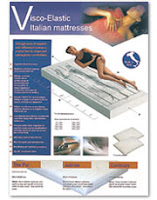 e from other foams, which makes it less ‘springy’ and slower to recover (hence ‘memory foam’ — it ‘remembers’ your shape for a while after you’ve moved).
e from other foams, which makes it less ‘springy’ and slower to recover (hence ‘memory foam’ — it ‘remembers’ your shape for a while after you’ve moved).You can buy viscoelastic mattresses (which have a layer of viscoelastic attached to another material, usually polyurethane foam) or viscoelastic overlays (which you put on your current mattress). The thicker the viscoelastic layer, the more you’ll sink in — which isn’t necessarily a good thing.
They’re reported to be very comfortable and luxurious feeling, and are excellent in terms of minimising partner disturbance. But they’re not for everyone – they’ve also been described as like ‘sleeping on wet or hard sand’.
Sensitive to weight and temperature, a viscoelastic mattress moulds to your body’s form, supporting it evenly, rather than having pressure concentrate at the shoulders, hips and feet. They’re used in some hospitals and nursing homes to help prevent pressure ulcers caused by lying in one position for a long time.
References to numerous ‘clinical trials’ and ‘clinically proven’ facts have been bandied about, although none of the mentioned trials has been published in the mainstream medical or scientific literature.
One such trial held over three months claimed that over 90% of people trying a particular brand of viscoelastic mattress experienced marked improvements in the quality of their sleep. Other studies claimed an 83% reduction in tossing and turning, and deeper sleep experienced by participants.
Our German counterparts tested viscoelastic mattresses and found they offered no particular advantages over other types, except for bedridden people, who may benefit from the pressure-spreading. Overall they tended to score less than foam, latex or pocket-spring mattresses and equal to regular (Bonnell-spring) inner-spring mattresses.
The main criticism was that the softness of the mattress makes it hard to move in your sleep, therefore requiring more physical effort. Heavy people in particular might find it difficult. Small movements (as opposed to full-scale tossing and turning, which is caused by blood-flow restriction at pressure points) are important for spine health.
However this may have been specific to the models tested. If you’re trying out one of these mattresses in a shop, see how easily you can move — if you feel bogged, try a thinner layer of viscoelastic.
Keep in mind that it takes about 15 minutes for the foam in some mattresses to fully warm up and soften, so what feels pleasantly firm at first (or unpleasantly hard) may not stay that way for long. So make sure you allow enough time to test mattresses properly when you’re buying. And not all memory foam feels the same, so if you like the idea of it, try different brands and models.
Finally: it just boils down to comfort.
